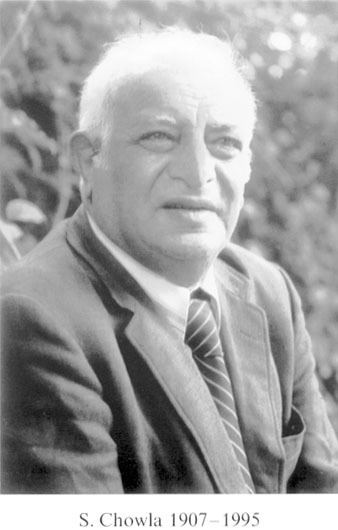Abdus Salam, born in Pakistan in 1926, was one of the most prolific...
In 1942, age 17, Abdus Salam joined the Government College Universi...
This was Salam's **beautiful insight that allowed him to crack the ...
For a general polynomial $f(t)=t^4+p_1t^3+p_2t^2+p_3t+p4$ we can wr...
To prove that $S_2+p_1S_1+2p_2=0$ we start by replacing $S_2=x^2+y^...
Note that $S_3=x^3+y^3+z^3+u^3$, multiplying (i)...(iv) by the corr...
How do we know
$S_{3} + p_{1}S_{2} + p_{2}S_{1} + 3p_{3}$ = 0 ?
For more information on how to solve a cubic equation you can read ...
For the three equation problem we have to solve a cubic equation \(...
For more information on how to solve a cubic equation you can read [this article](http://mathworld.wolfram.com/CubicFormula.html) about the cubic formula.
This was Salam's **beautiful insight that allowed him to crack the problem in a simpler and more elegant way**. It's also a testament to Salam's incredible intuition, always looking for symmetries and unseen correlations, which stayed with him throughout all his career and marked some of his biggest contributions in the Standard Model of Particle Physics.
How do we know
$S_{3} + p_{1}S_{2} + p_{2}S_{1} + 3p_{3}$ = 0 ?
I think you mean $S_3=ax+yx+ay+zy+az+uz+au+ux$
Thanks Steve! I see how it generalizes to
$S_{n} + p_{1}S_{n-1} + p_2S_{n-2} + ... + p_{n-1}S_1 + np_n = 0$
Isn't it tempting to define $S_0$? Only it doesn't work, does it? For the natural definition, $S_0 = \Sigma r^0$ would make $S_0 = 4$, not $3$. Shame that $\smile$.
I notice also that, even if $n$ is greater than the number of roots, say $N$, as long as we define $p_k$ to be zero when $k>N$ (a perfectly natural extension) the relation appears to still hold!
Now I'm looking for a slick general proof of the relation.
Shouldn't $p_1$ be $-(x+y+z+u)$? (I think you missed a minus).
Yes, just corrected the typo :)
Great!
In 1942, age 17, Abdus Salam joined the Government College University at Lahore. He enrolled to study Mathematics A and B, and English. One of his math teachers was Sarvadaman
Chowla.

Chowla went to Cambridge to do research under John Littlewood, who, with Godfrey Hardy, was one of the leading British mathematicians in the early 20th century, and who had guided Ramanujan. He later returned to India eventually joining Government College, Lahore, as Head of Mathematics. Chowla used to end his classes by setting a profound homework question. One day, he focused on the problem stated on this paper, which had been attacked by Ramanujan 25 years earlier.
Salam ended up finding a more elegant solution to the problem, which turned into his first published paper in 1943!
To prove that $S_2+p_1S_1+2p_2=0$ we start by replacing $S_2=x^2+y^2+z^2+u^2$, $p_2 = xy+zu+xz+xu+yz+yu$ and $S_1=-p_1$
to get
$$
S_2 -(x+y+z+u)^2+2(xy+zu+xz+xu+yz+yu) \\
= S_2-S_2-2(xy+zu+xz+xu+yz+yu)+2(xy+zu+xz+xu+yz+yu) \\
= 0
$$
For a general polynomial $f(t)=t^4+p_1t^3+p_2t^2+p_3t+p4$ we can write it as a function of the roots x,y,z,u as
$$
(t-x)(t-y)(t-z)(t-u)=0
$$
If we now expand it we get
$$
t^4-(x+y+z+u)t^3+(xy+zu+xz+xu+yz+yu)t^2 \\
-(xzu+yzu+zxy+uxy)t+xyzu=0
$$
matching every term in our initial expression for $f(t)$
$$
p_1 = -(x+y+z+u) = -S_1 \\
p_2 = xy+zu+xz+xu+yz+yu = \sum xy \\
p_3 = -(xzu+yzu+zxy+uxy) \\
p_4 = xyzu
$$
To derive $S_2$ we just have to use the initial relations (i)...(iv)
$$
S_2= \sum x^2 = x^2+y^2+z^2+u^2 \\
= (a+y)+(a+z)+(a+u)+(a+x) \\
= 4a+S_1 = 4a-p_1
$$
A very good question. It is a consequence of the theory of symmetric polynomial functions, but in this particular case it is easier to consider $p_1S_2$ from first principles.
We will not use any features of this particular problem, except the general definitions:
\begin{align*}
p_1 &= -\Sigma r & S_1 &= \Sigma r \\
p_2 &= \Sigma rs & S_2 &= \Sigma r^2 \\
p_3 &= -\Sigma rst & S_3 &= \Sigma r^3 \\
p_4 &= rstu \\
\end{align*}
where $r, s, t, u$ in each sum vary over all distinct combinations of roots. (It's a clumsy notation, but far more succinct than a precise one.)
Now, keeping track of the (four) roots in the expressions consider $p_1S_2$:
\begin{align*}
p_1S_2 & = -(\Sigma r)(\Sigma r^2) \\
& = -(\Sigma r^3) - (\Sigma rs^2) & \text{(the roots combine)}\\
& = -(\Sigma r^3) - (\Sigma rs)(\Sigma r) + 3(\Sigma rst) & \text{(3 extra terms each)}\\
& = -S_3 - p_2S_1 - 3p_3
\end{align*}
(Hint: consider each step's cross-terms considering where the distinct roots combine and fail to combine.)
This result generalises to any number of roots, save for the $3$ in the last line. Can you see why?
What in the original problem suggests treating `x`, `y`, `z`, and `u` as roots of a biquadratic? What's the connection between the two concepts?
For the three equation problem we have to solve a cubic equation \(t^3+p_1 t^2+p_2 t+p_3=0\). After some algebraic manipulation we get:
\(p_2=(p_1^2+p_1-3a)/2\), and
\(p_3=1+p_1 p_2\)
\(p_1\) is the solution of the cubic equation \(p_1^3+(1/2) p_1^2+(1/2-a)p_1+(3-3a/2)=0\)
Abdus Salam, born in Pakistan in 1926, was one of the most prolific theoretical physicists of the 20th century. Together with Sheldon Glashow and Steven Weinberg he won the 1979 Nobel Prize in Physics for his contribution to the electroweak unification theory and the Standard Model of Particle Physics (the theory describing three of the four known fundamental forces in the universe, as well as classifying all known elementary particles).
If you're interested in the life of Abdus Salam, I highly recommend whatching the documentary: [The First ****** Nobel Laureate](https://www.youtube.com/watch?v=UbW4wawEwSw&)

## TL;DR
This was the first paper ever published by Salam at the age of 17. It's about a more elegant solution to one of Ramanujan's problems. Besides showing the outstanding mathematical intuition of Salam at such a young age the story behind the paper is a perfect example of how brilliant teachers can have a deep influence on the life and career paths of students.
Note that $S_3=x^3+y^3+z^3+u^3$, multiplying (i)...(iv) by the corresponding variable we get $S_3=ax+yx+ay+az+az+uz+au+ux$, which can be simplified to $S_3=aS_1+xy+zy+ux+uz= -ap_1-1$